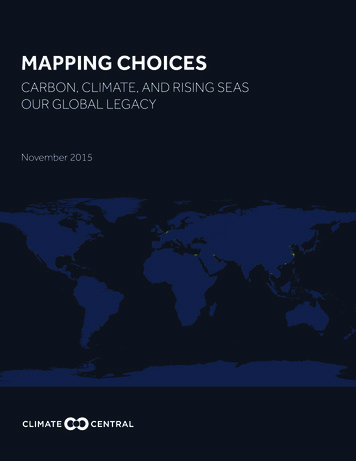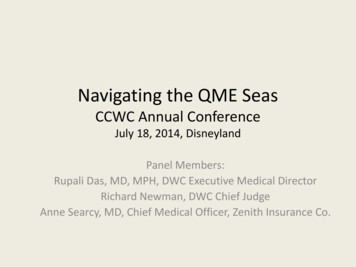
Transcription
MAPPING CHOICESCARBON, CLIMATE, AND RISING SEASOUR GLOBAL LEGACYNovember 2015
This page intentionally blank
MAPPING CHOICESCARBON, CLIMATE, AND RISING SEASOUR GLOBAL LEGACYABOUT CLIMATE CENTRALClimate Central surveys and conducts scientific research on climate change and informs the publicof key findings. Our scientists publish and our journalists report on climate science, energy, sea levelrise, wildfires, drought, and related topics. Climate Central is not an advocacy organization. We donot lobby, and we do not support any specific legislation, policy or bill. Climate Central is a qualified501(c)3 tax-exempt organization.Climate Central scientists publish peer-reviewed research on climate science; energy; impacts suchas sea level rise; climate attribution and more. Our work is not confined to scientific journals. Weinvestigate and synthesize weather and climate data and science to equip local communities andmedia with the tools they need.November 2015Princeton: One Palmer Square, Suite 330 Princeton, NJ 08542Phone: 1 609 924-3800Toll Free: 1 877 4-CLI-SCI / 1 (877 425-4724)www.climatecentral.orgCover: Image shows night lights on land that could be submerged by long-term sea level rise after 4 C warming.Night lights satellite imagery data source: NASA.2MAPPING CHOICES
REPORT AUTHORSBENJAMIN H. STRAUSS, PhD, LeadVice President for Sea Level Rise and Climate Impacts, Climate CentralDr. Strauss is the Vice President for Sea Level Rise and Climate Impacts at Climate Central, and thefounder and scientific and creative driver behind Surging Seas. He has published multiple peerreviewed papers on sea level rise, which have been downloaded more than 40,000 times; testifiedbefore the U.S. Senate; and led development of the SurgingSeas.org suite of sea level and coastalflood risk maps, tools, and visualizations. This research and creative work have led to coveragein more than 2,000 news stories including multiple front-page articles in the New York Timesand Washington Post, and repeat appearances for Strauss on NBC, CBS, PBS and NPR nationalprogramming. He holds a Ph.D. in Ecology and Evolutionary Biology from Princeton University, anM.S. in Zoology from the University of Washington, and a B.A. in Biology from Yale University.SCOTT KULP, PhDComputational Scientist and Senior Developer, Climate CentralDr. Scott Kulp serves as Computational Scientist and Senior Developer for Climate Central’s Programon Sea Level Rise, where his research interests include the impacts of sea level rise on coastalcommunities. Scott holds a Ph.D. in Computer Science from Rutgers University for his work on thetopic of cardiac blood flow simulations. Previously, Dr. Kulp has worked for the U.S. Department ofDefense on several research projects, such as the simulation of iris tissue deformation and GPUaccelerated neural networks.ANDERS LEVERMANN, PhDCo-chair of the Research Domain Sustainable Solutions at Potsdam Institute for Climate ImpactResearch and Physics Professor at Potsdam University, GermanyAnders Levermann is a climate scientist and physics professor. He was a lead author of the sea-levelchapter of the latest U.N. climate report. His research focuses on large-scale abrupt changes withpotentially strong impacts on nature and society, in systems ranging from the Antarctic ice sheet toocean dynamics to monsoon rainfall. Since 2012 he has led research on global adaptation strategiesat the Potsdam Institute, developing an economic damage propagation model for the globalproduction and supply network. Prof. Levermann has published more than 80 scientific papers, andadvises government representatives, members of parliament, political parties, economic stakeholdersand journalists with respect to climate change issues.3MAPPING CHOICES
ACKNOWLEDGMENTSWe thank Mark Merrifield for providing high-resolution model outputs of global high tide levels insupport of this research, and we thank Claudia Tebaldi, Stanley Jacobs, Nathan Gillett, and MichaelOppenheimer for the contributions they made to our thinking as we wrote the paper upon whichthis report is based, in the Proceedings of the National Academy of Sciences United States of America. Wealso thank Climate Central’s financial supporters for this project and the sea level rise program: the V.Kann Rasmussen Foundation, The Kresge Foundation, The Schmidt Family Foundation, and others.SUGGESTED CITATIONStrauss, B. H., Kulp, S. and Levermann, A. 2015. Mapping Choices: Carbon, Climate, and RisingSeas, Our Global Legacy. Climate Central Research Report. pp. 1-38.4MAPPING CHOICES
CONTENTSExecutive Summary 6Introduction and ApproachSea Level Projections77Elevation Analysis and Maps8Population Analysis9Global Coast, Nations and Cities at Risk10Detailed Methods 17References 19Appendix 215MAPPING CHOICES
EXECUTIVE SUMMARYCarbon emissions causing 4 degrees Celsius of warming (7.2 degrees Fahrenheit) — a business-asusual scenario — could lock in enough eventual sea level rise to submerge land currently home to470 to 760 million people globally. Carbon cuts resulting in the proposed international target of 2 Cwarming (3.6 F) would reduce the rise locked in so that it would threaten areas now occupied by asfew as 130 million people. This contrast is one expression of what is at stake in the December 2015global climate talks in Paris.This report builds closely on a paper first published online in October 2015 in the Proceedings ofthe National Academy of Sciences of the United States of America by the same authors. That researchused relationships between cumulative carbon emissions, warming, and the future global sea levelrise they lock in to assess implications for the United States and its cities. What distinguishes thecurrent report is its application of sea level projections to global elevation, tidal, population, andadministrative boundary data, instead of U.S. data only.Among all nations, this report finds that China has the most to lose from business as usual, with 145million citizens today on implicated land. China also has the most to gain from limiting warming to2 C, which would cut the total to 64 million. Twelve other nations have more than 10 million peopleliving on implicated land under 4 C warming — India, Bangladesh, Viet Nam, Indonesia, Japan, theUnited States, Philippines, Egypt, Brazil, Thailand, Myanmar, and the Netherlands, in descendingorder of total threats. A carbon path that limits warming to 2 C would reduce exposure by morethan 10 million in each listed nation except the last two, and by half or more in all listed nations butViet Nam (still achieving 44% reduction), Brazil (45%) and the Netherlands (13%). Global megacitieswith the top ten populations in the balance include Shanghai, Hong Kong, Calcutta, Mumbai, Dhaka,Jakarta, and Hanoi. 4 C warming could lead to submergence of land inhabited by more than half thepopulation of Shanghai, Mumbai and Hanoi, among these.These results are based on median sea level rise projections. They are also based on global elevationdata with a tendency to understate exposure.Carbon emissions this century can lock in these projected threats, but the associated sea level rise isexpected to play out over a longer period, likely centuries.This report assesses and lists global nations and urban agglomerations at risk by projected totalpopulation exposure, percent exposure, and differences in exposure under warming scenarios of 1.5,2, 3 and 4 C (2.7, 3.6, 5.4 and 7.2 F). Results do not account for present or future shoreline defenses,such as levees, that might be built, nor for future population growth, decline or relocation.In conjunction with this report, Climate Central has extended its interactive and embeddableMapping Choices platform globally (choices.climatecentral.org). Users can now type in any coastalcity name or postal code worldwide, and visually compare the potential consequences of differentwarming or emissions scenarios on a local map. Climate Central is also serving Google Earth layers forvisualizing sea levels associated with 2 C or 4 C warming in areas with 3-D building data, availablehere; and offering spreadsheets for download with analytic results for comprehensive lists of globalnations and coastal urban agglomerations, available here.6MAPPING CHOICES
01. INTRODUCTION AND APPROACHCarbon pollution casts a long shadow. It is expected to persist in the atmosphere long enoughto prolong temperature increases for thousands of years, long after human beings stop burningfossil fuels or clearing forests (Solomon et al. 2009). This research translates global temperatureincreases from carbon emissions into projections of locked-in long-term sea level rise, and puts theseprojections into context by assessing the current global population living on land that could besubmerged.Analysis focuses on the consequences of 2 C warming, a long-standing international target andthe widely understood goal for the December 2015 global climate talks at COP21 in Paris; on theconsequences of 4 C warming, the approximate implication from the current path of carbonemissions and representative of a failure of talks; and on the differences between these scenarios.1.5 C warming, the preferred goal for many island nations, and 3 C warming, are also considered.SEA LEVEL PROJECTIONSThe sea level projections corresponding to these levels of warming are taken from a paper written bythe same authors as this report. That paper was published in October 2015 in the Proceedings of theNational Academy of Sciences of the U.S.A. (Strauss et al. 2015). What distinguishes the current reportis its application of sea level projections to global elevation, tidal, population, and administrativeboundary data, instead of U.S. data only. Additionally, this report focuses on scenarios defined bywarming levels, as opposed to carbon emissions pathways, in order to align most closely with thecurrent global discussion around warming targets.Four separate models underlie the global sea level projections employed here: one for the expansionof ocean water as it warms; one for melting glaciers; and one each for the decay of Greenland andAntarctic ice sheets. These global projections are then localized based mainly on changes in gravityfields across the surface of the Earth due to mass loss from polar ice sheets, leading to local sea leveldifferences that can exceed a meter. Details of the global models and the localization approach canbe found in Levermann et al. (2013). Local projections do not factor in the continuation of currentland subsidence or uplift. In most places, these might translate to centimeters per century, but somedeltas and urban areas are experiencing much more rapid subsidence due to factors such as sedimentcompaction, sediment supply reduction, and groundwater withdrawal.Some research has suggested that the West Antarctic Ice Sheet has already begun an unstoppablecollapse (Favier et al. 2014, Joughin et al. 2014, Rignot et al. 2014), which would lead to roughly3.3 meters (m) of sea level rise by itself (Bamber et al. 2009, Feldmann & Levermann 2015); but theevidence is far from conclusive (Golledge et al. 2015; Strauss et al. 2015). This report does not assumeinevitable West Antarctic collapse. If collapse has in fact begun, all locked-in sea levels would behigher than those reported and analyzed here, for example by an expected 1m in the 2 C warmingcase, and 0.5 m in the 4 C case: these scenarios of inevitable collapse are detailed and analyzed inStrauss et al.7MAPPING CHOICES
01. INTRODUCTION AND APPROACHThe projections in this report do not forecast what sea levels may unfold this century. Rather, theyindicate the different post-2100 sea levels that could lock in this century, depending upon the carbonpathway we select and the warming thus achieved. The sea levels described could possibly, but withlow probability, occur sooner than 200 years from now (Kopp et al. 2014), or be reached as far as 2,000years in the future (Levermann et al. 2013). This wide range stems from the fact that it is easier toestimate how much ice will eventually melt from a certain amount of warming, than how quickly it willmelt, which involves more unknowns. The same simple contrast would apply to a pile of ice in a warmroom.The sea may rise higher still over longer time frames (Dutton et al. 2015, Winkelmann et al. 2015), butthose possibilities are beyond the scope of this analysis.ELEVATION ANALYSIS AND MAPSBased on projected sea levels, together with current sea level, tidal and elevation data, this analysisdevelops maps delineating global areas that could be submerged under different warming scenarios.These maps are the foundation for this study’s population exposure assessments, and also for ClimateCentral’s interactive online Mapping Choices platform (choices.climatecentral.org, see Figure 1),extended from U.S. to global coverage to coincide with this report release. Users can type in anycoastal city name or postal code worldwide, and visually compare the potential consequences ofdifferent warming or emissions scenarios on a local map.Figure 1. Screenshot from Mapping Choices (choices.climatecentral.org) showing projectedlocked-in sea levels under different scenarios in Shanghai, China.8MAPPING CHOICES
01. INTRODUCTION AND APPROACHClimate Central is also offering access to the same map layers for visualizing sea levels associated with2 C or 4 C warming within Google Earth.This analysis uses elevation data on a roughly 90-meter horizontal resolution grid derived fromNASA’s Shuttle Radar Topography Mission (SRTM). SRTM provides surface elevations, not bare earthelevations, causing it to commonly overestimate elevations, especially in areas with dense and tallbuildings (Gamba et. al, 2002) or vegetation (Shortridge et. al, 2011) . Therefore, this analysis very likelyunderestimates, and Mapping Choices under-portrays, areas that could be submerged at each lockedin sea level, and so the following analysis and visualization should be seen as likely lower bounds.SRTM data also do not cover latitudes farther north than 60 degrees or farther south than 56 degrees,meaning that sparsely populated parts of Arctic Circle nations are not mapped or analyzed here.POPULATION ANALYSISBased on the submergence threat areas delineated, plus recent global population and administrativeboundary data, this analysis assesses the number of people today living on land implicated under eachwarming scenario, by city, by nation and globally. The individuals counted will almost certainly notexperience anything close to the full sea level rise projected, but population exposure makes a strongproxy for the exposure of infrastructure, landmarks, and areas of economic and cultural importance,due to correspondence between population and development.Boundary data for cities, defined by the Natural Earth dataset (Natural Earth, 2012), delineate broadurban agglomerations or metropolitan areas, so population totals (across each city as a whole) mayexceed familiar population values for city administrative units.Due to this study’s likely underestimation of areas threatened with future submergence, stemmingfrom use of SRTM elevation data, the analysis also likely understates population exposure on this land.As a known example, this report underestimates exposure in the U.S. by 18% after 4 C of warming, ascompared to Strauss et al., and by 36% after 2 C of warming.Results do not account for present or future shoreline defenses, such as levees, that might be built, norfor future population growth, decline or relocation.9MAPPING CHOICES
02. GLOBAL COAST, NATIONS ANDCITIES AT RISKThis analysis finds that carbon emissions causing 4 C of warming could lock in a median of 8.9 mof long-term global sea level rise, enough to submerge land home (in 2010) to 627 million peopleglobally. Carbon cuts resulting in the proposed international target of 2 C warming could reducethese numbers to medians of 4.7 m in sea level rise and 280 million people. Table 1 provides 66%confidence intervals for these assessments, and evaluations for 1.5 C and 3 C scenarios as well.Table 1. Global sea level commitments for different warming levels, and current global populationon threatened landWarming ( C)Locked-in sealevel rise (meters)2010 globalpopulation belowlocked-in sea level(millions)1.52.91.6 - 4.213751 - 29124.73.0 - 6.3280130 - 45836.44.7 - 8.2432255 - 59748.96.9 - 10.8627470 - 760Shaded columns give 17th-83rd percentile estimates, or the 66% confidence intervalFigure 2 illustrates the complete global distribution of long-term coastal threats from 4 C warmingand 2 C warming, and the differences, across all nations. China has the most to lose from businessas usual, with a median of 145 million citizens today on implicated land. China also has the mostto gain from limiting warming to 2 C, which would cut the total to 64 million. The six most at-risknations, as measured by total 2010 population on threatened land (Table 2a), and 9 of the 10 mostat-risk nations, as measured by percent of population in the same places (Table 2b), are in Asia. Morebroadly, 74% of the global population on implicated land live in Asia, a larger share compared to the59% of global population inhabiting Asia overall.At the same time, every other populated continent except Australia is represented in both top-20lists, with the most people on implicated land among these in the United States, Egypt, Brazil and theNetherlands.10MAPPING CHOICES
02. GLOBAL COAST, NATIONS AND CITIES AT RISK(a)(d)(b)(e)(c)(f)NA0-51020 Millions of people4080150NA0-5%10%20%30%40%100%Percentage of national populationFigure 2. Total population living on land that could be submerged by long-term sea level rise lockedin after (a) 4 C warming or (b) 2 C warming. Panel (c) reflects the difference between these totals, inother words, the difference achieved by limiting warming to 2 C instead of 4 C. Panels (d)-(f ) reflectthe same quantities except measured as percentages of total national population.11MAPPING CHOICES
02. GLOBAL COAST, NATIONS AND CITIES AT RISKTable 2a.Top 20 countries most affected by locked-in sea level rise from 4 C warming, by totalpopulation, with comparisons to 2 C warming2010 population below median locked-in sea level risefrom different warming amounts (millions)Country4 C2 Viet Nam462620Indonesia441628Japan341817United laysia725Mexico633United Kingdom642Italy532South Korea413Taiwan412Only larger nations with at least 25 million in total population are shown in Table 2b. Several smallernations have much larger percentages of their population on land at risk from 4 C warming, withseveral small island nations (Marshall Islands, 93%; Cayman Islands, 88%; Tuvalu, 81%; Kiribati, 77%;Bahamas, 76%; and the Maldives, 73%), Suriname (84%), Guyana (72%), and the Netherlands (67%)comprising the top ten. Among these, Kiribati and the Maldives would be the greatest beneficiariesof holding warming to 2 C, reducing exposure by 48 and 42 percentage points, respectively.12MAPPING CHOICES
02. GLOBAL COAST, NATIONS AND CITIES AT RISKTable 2b.Top 20 countries most affected by locked-in sea level rise from 4 C warming, bypercent of population, with comparisons to 2 C warming2010 population below median locked-in sea level risefrom different warming amounts (percent)Country4 C2 CDifferenceViet 5%6%Iraq11%5%6%United Kingdom10%6%3%Saudi Arabia9%3%6%Brazil8%5%4%Argentina8%3%5%South Korea8%2%6%Venezuela8%5%3%United States8%4%4%Italy8%5%3%Spain6%3%3%Only countries with total 2010 populations exceeding 25 million are included.Among larger nations, Bangladesh, India and Indonesia — after China — would see the biggestabsolute coastal benefits from limiting warming to 2 C. Overall, 10 countries could each see landhome to more than 10 million spared. The most striking relative benefits would be in Malaysiaand Bangladesh, where roughly one quarter the people live on land at risk from 2 C warming, ascompared to 4 C; South Korea, where fewer than one-third do; and fourteen other nations fromTables 2a and 2b where the threat reduces to less than half, including India, Indonesia, Saudi Arabia,Nigeria, Argentina, Mexico and the United States.Switching focus to urban developments, the majority of the world’s megacities are in Asia —including all twenty with the most population on low-lying land implicated by long-term sea levelrise after 4 C warming. Shanghai, Tianjin and Hong Kong in China; Mumbai and Calcultta in India;and Dhaka in Bangladesh each have more than 10 million residents on such land, with Shanghaitopping 20 million (Table 3a).13MAPPING CHOICES
02. GLOBAL COAST, NATIONS AND CITIES AT RISKTable 3a. Top 20 urban agglomerations most affected by locked-in sea level rise from 4 Cwarming, by total population, with comparisons to 2 C warming2010 population below median locked-in sea level risefrom different warming amounts (millions)Urban AgglomerationCountry4 C2 05.66.4MumbaiIndia10.85.85.0Hong uChina8.96.12.8KhulnaBangladesh7.62.65.0HanoiViet Ho Chi Minh CityViet bayaIndonesia5.52.72.8Shanghai also leads the list of megacities with the greatest percentage of population on at-risk land(Table 3b). Three non-Asian cities make the top-20 percentage list: Rio de Janeiro, New York, andBuenos Aires. A 4 C warming scenario could lock in enough sea level rise to submerge land inhabitedby half or more of today’s population in Shanghai and Shantou, China; Haora, Calcutta and Mumbai,India; Hanoi, Viet Nam; and Khulna, Bangladesh.14MAPPING CHOICES
02. GLOBAL COAST, NATIONS AND CITIES AT RISKTable 3b.Top 20 urban agglomerations most affected by locked-in sea level rise from 4 Cwarming, by percent of population, with comparisons to 2 C warming2010 population below median locked-in sea level risefrom different warming amounts (percent)Urban AgglomerationCountry4 C2 CDifferenceShanghaiChina76%39%37%HanoiViet umbaiIndia50%27%23%Hong Rio de JaneiroBrazil24%13%11%New YorkUnited donesia22%11%11%ShenzhenChina20%9%11%Buenos AiresArgentina19%8%10%CuttackIndia18%7%11%Quezon CityPhilippines18%9%9%Only urban agglomerations with total 2010 populations in this analysis exceeding 10 million are included.Total populations estimated from LandScan data totaled within urban area boundaries from Natural Earth.Tokyo and Jakarta are among the cities making both total- and percentage-based lists. Acrossboth lists, limiting warming to 2 C would cut the threat by more than half in thirteen megacities,led by Dhaka, Bangladesh, where fewer than one-sixth as many people live on land at risk after 2 C warming, as opposed to 4 C. Haora, India and Wuxi, China would see their risks cut more thanthreefold.15MAPPING CHOICES
02. GLOBAL COAST, NATIONS AND CITIES AT RISKAt 2 C warming, the locked-in sea level rise projected would not submerge land home to morethan half of today’s population in any listed megacity. Five, however, would still be more than 25%affected: Shanghai, Hong Kong, Hanoi, Mumbai, and Osaka.The report appendix includes results for all nations, including confidence intervals (Table A1), and fornot just megacities, but all urban agglomerations with 2010 total populations exceeding one million(Table A2). These data and more are also available for download in spreadsheet form.16MAPPING CHOICES
03. DETAILED METHODSThis analysis employs spatially varying global projections of sea level commitments that are identicalto those in Strauss et al. for fixed warming levels of 1.5 C, 2 C, 3 C, and 4 C. It uses the same 66%confidence intervals developed from independent random sampling of parameter values for eachof the four sea level rise component submodels, and the same application of spatial fingerprintsmodifying the local sea level influence of Greenland and Antarctic ice sheet losses.In order to work with elevation, tidal and population datasets available globally, as opposed to theU.S. data employed in Strauss et al., this report modifies details of some of the ensuing steps, whilepreserving the same general approach of assessing population on land below different sea levelincrements, when added to local high tide lines.To begin, in place of lidar-based bare earth elevation data, which has very limited availabilityoutside the U.S., this analysis uses 3-arcsecond horizontal resolution SRTM data (Farr et. al, 2007).As distributed by NASA, SRTM is referenced to the EGM96 geoid (SRTMEGM96). The analysis employsa series of steps to convert the vertical reference frame to refer to the local mean higher-high water(MHHW) tidal datum (SRTMMHHW ): Begin with the global 2-arcminute mean sea surface MSS CNES CLS 11 (Aviso 2014)based on 16 years of satellite altimetry observations (1993-2009), referenced to theTopex-Poseidon ellipsoid, and here called MSLTP (MSL for mean sea level);Employ a global MHHW grid, MHHWMSL, referenced to the MSL tidal datum, provided byMark Merrifield of the University of Hawaii, and developed using the model TPXO8 at2-arcminute resolution (Egbert et. al, 2002);Upsample these grids to 3-arcsecond SRTM resolution and georeference using nearestneighbor interpolation;Convert both SRTMEGM96 and MSLTP to reference the WGS84 ellipsoid;Convert MHHW grid to reference WGS84 through the operation,MHHWWGS84 MSLWGS84 MHHWMSL;Convert SRTM to MHHW reference through the operation,SRTMMHHW SRTMWGS84 - MHHWWGS84.A series of flood maps are then produced by thresholding SRTMMHHW to elevations 0.5-15 m aboveMHHW in 0.5 m increments. Each map can be labeled SRTM.THRESHXm, where X is the flood height.To prevent inclusion of isolated inland areas below sea level, such as the Caspian Sea or Death Valley,from being counted in analyses such as these, a common approach uses connected componentsanalysis to remove those regions that are not directly connected to the ocean; call the resultingflood maps SRTM.CONTINGXm. However, the high-frequency error present in SRTM creates significantspeckle noise in threshold-based floodmaps, which causes some truly connected areas to appearisolated.17MAPPING CHOICES
03. DETAILED METHODSThis analysis instead conducts the connected components analysis at the 10 m and 20 m flood levels,and performs the operationSRTM.HYBRIDXm SRTM.THRESHXm SRTM.CONTINGYm,where Y 10 if X 10, and Y 20 if 10 X 20. This intersection operation ensures that SRTM-HYBRIDXmis not overly sensitive to speckle noise, but isolated, low-lying regions will still not be counted, so longas ridges exceeding 10 m or 20 m separate them from coastal zones. All local sea level rise incrementsconsidered for warming below 4 C are below 10 m, and the great majority of local increments for 4 C are also below 10 m.For population density data, this analysis employs the LandScan edition for 2010, produced by Brightet al. (2011), which provides total estimated populations living in 1 km square cells across the Earth.The SRTM Water Body Dataset (SWBD) is utilized to define land cells at SRTM resolution. For eachcell in LandScan, the analysis counts the number of SWBD-defined land pixels within it, and dividesthe cell population by the count to find per-pixel population density. A new raster, LSDensity, is thusdefined, georeferenced identically to SRTM, and in which each pixel is set to zero if SWBD defines it asnon-land, or otherwise is set to its population density.This report uses urban agglomeration boundaries defined by the Natural Earth dataset (Natural Earth,2012) plus level-two (county equivalent) administrative boundaries defined by the GADM dataset(Global Administrative Areas, 2015), to assess threats at metropolitan through national levels. Foreach feature of interest in Natural Earth and GADM, the following recipe yields population on landbelow sea level rise locked in by different warming scenarios: 18Compute the population living 0.5-15 m above MHHW in increments of 0.5m, usingLSDensity;For each of the warming scenarios, look up the local sea level rise commitment, andthus elevation of the future high tide line (MHHW), at the centroid of each feature(Natural Earth and level-two GADM);Linearly interpolate among results at 0.5-15 m to find the number of people living onland below this elevation for each feature (completing the recipe for cities); andSum the population exposure within the GADM level-two administrative areas tocompute total committed populations within each nation.MAPPING CHOICES
04. REFERENCESAviso. (2014). MSS CNES CLS10 was produced by CLS Space Oceanography Division and distributedby Aviso, with support from Cnes (http://www.aviso.altimetry.fr/). Accessed September 2014.Bamber J.L., Riva R.E.M., Vermeersen B.L., & LeBrocq A.M. (2009). Reassessment of the potential sealevel rise from a collapse of the West Antarctic Ice Sheet. Science 324(5929):901–903.Bright, E. A., Coleman, P. R., Rose, A. N., & Urban, M. L. (2011). Landscan 2010. Oak Ridge NationalLaboratory.Dutton A., et al. (2015).
usual scenario — could lock in enough eventual sea level rise to submerge land currently home to 470 to 760 million people globally. Carbon cuts resulting in the proposed international target of 2 C warming (3.6 F) would reduce the rise locked in so that it would thr











